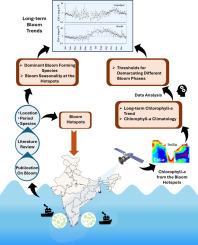确定表征藻华条件的叶绿素-a阈值:海洋颜色遥感方法。
IF 8
1区 环境科学与生态学
Q1 ENVIRONMENTAL SCIENCES
引用次数: 0
摘要
在过去的几十年里,印度海岸的藻华事件一直在增加。由于藻类生物量的区域和季节动态(代表:叶绿素-a,以下简称chl-a),已经为全球海洋的不同地区确定了大量的chl-a阈值,以确定藻华条件。然而,印度沿海水域却没有这样明确的定义。目前的研究定义了chl-a阈值,用于划分印度沿海水域的藻华条件,考虑了热点地区的变化(根据报告的事件:次要数据)、致病物种和卫星检索的长期趋势。二级数据分析确定了印度东海岸和西海岸的9个开花热点。与鞭毛藻和蓝藻相比,藻华中硅藻最多。对卫星反演的每日chl-a异常进行四分位数分析,以确定特定的水华阈值。因此,这些四分位数阈值被用来对不同的开花阶段进行分类,例如第25百分位数(可能开花)、第50百分位数(开花)、第75百分位数(强烈开花)和第90百分位数(极端开花)。根据这种基于百分位数的分类,“Bloom”类别对应的chl范围分别为0.89-0.94 mg m-3和0.76-2.87 mg m-3,分别位于东海岸和西海岸已确定的热点地区。同样,在“强烈水华”阶段,东部和西部沿海热点地区的chl-a浓度分别超过0.99-1.47和1.12-4.46 mg -3。在西南季风前,印度中东部沿海的开花季节性呈增加趋势。在西海岸,西南季风期间的显著上升流已被证实有利于开花。本研究为利用沿海水域的卫星数据检测不同阶段的水华提供了一条途径,由于各种因素,现场观测受到限制。本文章由计算机程序翻译,如有差异,请以英文原文为准。

Determining chlorophyll-a thresholds for characterizing algal bloom conditions: An ocean colour remote sensing approach
The Indian coast has been experiencing an increase in algal bloom events over the decades. Owing to the regional and seasonal dynamics of algal biomass (proxy: chlorophyll-a, hereafter chl-a), a multitude of thresholds of chl-a has been defined for different parts of the global seas to determine algal bloom conditions. However, no such clear definition is given for the Indian coastal waters. The current study defined chl-a thresholds to demarcate algal bloom conditions for the coastal waters of India, accounting for the variability at hotspots (in accordance with reported events: secondary data), causative species, and satellite-retrieved long-term trends. The secondary data analysis identified nine bloom hotspots along the east and west coasts of India. Among the blooms, diatoms prevailed the most, compared to dinoflagellates and cyanobacteria. Quartile analysis was employed on satellite-retrieved daily chl-a anomaly to determine specific bloom thresholds. Consequently, these quartile thresholds were utilized to classify various bloom phases, such as the 25th percentile (Likely to Bloom), 50th percentile (Bloom), 75th percentile (Intense Bloom), and 90th percentile (Extreme Bloom). As per this percentile-based classification, the ‘Bloom’ category corresponds to a chl-a range of 0.89–0.94 mg m−3 and 0.76–2.87 mg m−3, for the identified hotspots along the east and west coasts, respectively. Likewise, during the ‘Intense Bloom’ phase, the chl-a concentration exceeds 0.99–1.47 and 1.12–4.46 mg m−3 at the hotspots along the east and west coasts, respectively. The seasonality of blooms revealed an increasing trend during the pre-southwest monsoon period on the central east coast of India. On the west coast, significant upwelling during the southwest monsoon period has been substantiated to be conducive for blooms. This study provides an avenue towards utilization of the threshold criteria in detecting different phases of bloom using satellite data in coastal waters where field observations are limited due to various factors.
求助全文
通过发布文献求助,成功后即可免费获取论文全文。
去求助
来源期刊

Science of the Total Environment
环境科学-环境科学
CiteScore
17.60
自引率
10.20%
发文量
8726
审稿时长
2.4 months
期刊介绍:
The Science of the Total Environment is an international journal dedicated to scientific research on the environment and its interaction with humanity. It covers a wide range of disciplines and seeks to publish innovative, hypothesis-driven, and impactful research that explores the entire environment, including the atmosphere, lithosphere, hydrosphere, biosphere, and anthroposphere.
The journal's updated Aims & Scope emphasizes the importance of interdisciplinary environmental research with broad impact. Priority is given to studies that advance fundamental understanding and explore the interconnectedness of multiple environmental spheres. Field studies are preferred, while laboratory experiments must demonstrate significant methodological advancements or mechanistic insights with direct relevance to the environment.
 求助内容:
求助内容: 应助结果提醒方式:
应助结果提醒方式:


